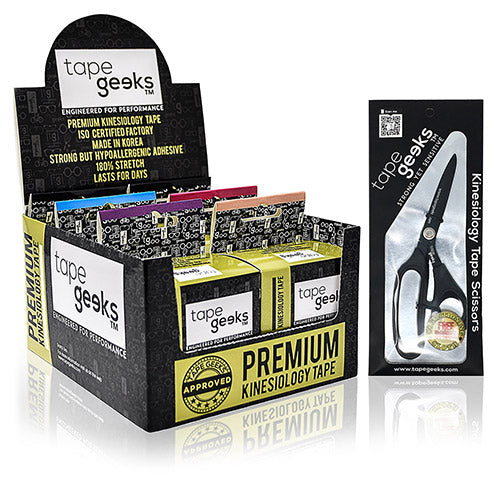
Upper back pain is a common problem that affects people of all ages. It can be caused by a variety of factors, including poor posture, muscle strains, and arthritis.
Are you currently suffering from upper back pain?
In this article, we’ll talk about the causes of upper back pain, its symptoms, available treatments, and how to prevent them in the future. We’ll also be talking about how kinesiology tape in providing support in the area and how it can help alleviate discomfort.

Shop our kinesiology tape now
Shop Now
What causes upper back pain?
Some of the most common causes of upper back pain include:
- Overuse. When you put more pressure on the back than what it is used to, it may cause inflammation and strain in the muscles and ligaments in the upper back.
- Bad posture. Having poor posture due to a sedentary lifestyle or having the habit of sitting with a poor posture for long periods can change the structures of the back and neck. This causes the neck and the spine to weaken. In turn. it will be unable to hold the head in a neutral position as easily.
- Improper lifting technique. When lifting, it’s crucial to have the spine aligned. Otherwise, it may place excessive pressure on the upper back. Remember to keep the heavy object you’re lifting above the head to be centered. Otherwise, if it’s leaning more to the left or the right, it may leave you more susceptible to injury.
- Pinched nerve. Often a result of repetitive motion, a pinched nerve happens when there is pressure or compression on the nerve near the upper back.
- Trauma from an accident. Experiencing a fall from a significant height, a car crash, or having a sports injury may all contribute to experiencing upper back pain.
What are the common symptoms of upper back pain?

- Sharp pain. Rather than the pain felt through the entire upper back area, it’s described to be a knife-like pain situated in one spot.
- Stiffness. As the pain becomes worse, it can result in limited mobility in the upper back muscles, ligaments, and joints. This, in turn, may affect arm movements, making them challenging to do. This could include lifting and rotating your arms.
How do you diagnose upper back pain?
- X-ray
- MRI (Magnetic Resonance Imaging)
- Bone Mineral Density Exam
Who is prone to upper back pain?

Some of the factors that increase your risk for back pain include:
- Age. People in their 30s or 40s are more susceptible to developing back pain.
- Weight. Having excess weight puts more pressure and strain on the back leading to back pain.
- Smoking. Being a smoker makes you more at risk to smoker’s cough - a condition that can strain your back. Smoking also slows down healing, making your back pain last much longer.
How do you treat or relieve upper back pain?
Treatment options vary depending on the cause of the upper back pain but may include:
- Over-the-counter-pain (OTC) medication. Taking OTC medication may help with reducing pain and inflammation. Some of the drugs that you may take are aspirin, ibuprofen, naproxen, and acetaminophen.
- Apply ice and/or heat. Applying ice may help in reducing inflammation and swelling. After 48 hours, applying heat is also recommended. When applying ice or heat, you should limit it to 15-20 minutes at a time to avoid damaging your tissues.
- Kinesiology tape. The kinesiology tape lifts the skin and increases blood flow and circulation in the area. The tape also helps reduce pressure off the area while giving support.
- Physical therapy. A physical therapist or other qualified medical professionals may design a physical therapy program for you depending on your case. These treatments may involve strengthening and stretching exercises that focus on your upper back muscles.
- Surgery. While rare, some severe upper back pain cases may require surgery to treat.

Shop our bundles now
Shop Now
How do you apply kinesiology taping for the upper back?
Before your upper back pain application, here are some tips on how to prepare beforehand. And, since you’ll be applying different kinesiology tape tensions, learn more about it here.
*In applying this protocol, we recommend having a partner to help you as it is a hard-to-reach area.
Here’s how you can apply kinesiology tape on the upper back pain to help with discomfort brought about by muscle strain:
- Prepare two strips of kinesiology tape.
- Start in a normal posture. Next, roll your shoulders forward to stretch the muscles in the area.
- Have your partner get the first strip and anchor it on top of the scapula. Give the middle of the tape 100% tension and apply it towards the top of the neck.
- With the second strip, anchor it on the same spot as the first strip. Give the middle of the 100% tension and apply it down towards the spine.
- Rub the tape to activate the adhesive.
Tape Geeks: The One-Stop-Shop for Your Kinesiology Taping Needs!

Shop our kinesiology tape now
Shop NowIf you’re turning to kinesiology tape to aid upper back issues, you may need to consider the quality of the tape that you’re using!
Avoid rashes and allergies while getting great support for your muscles and joints with Tape Geeks.
Get the best deals for Tape Geeks' kinesiology tape by visiting our Amazon store today!
How do you prevent upper back pain?
Here are some things that you can do to avoid upper back pain:
- Practice good posture. Maintaining good posture whether you’re sitting, standing, or walking around reduces your risk of back pain. Doing so keeps your spine neutral and prevents undue pressure on the area.
- Work on your form when lifting weights.Maintaining proper form when lifting weights protects your upper back muscles from.
Conclusion
If you are experiencing upper back pain, it’s important to seek medical attention to find the root of the problem and get appropriate treatment. There are many treatments available for upper back pain, ranging from medication to physical therapy to kinesiology tape.
You can read more about different aches and pains like neck pain as well as abdominal strain. Visit the Tape Geeks blog today!
Thanks for reading!

Shop our collection now
Shop Now
Subscribe to the TapeGeeks Newsletter for new videos, discounts and more!Join The Geeks Club






